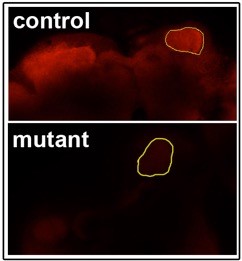27/10/2017
Anaesthesia Resistant Memory (ARM) has been puzzling because unlike Long Term Memory (LTM) is translation independent in Drosophila. Although the two forms of consolidated memory are housed within the mushroom body neurons, they seem to employ distinct molecular pathways with those that underlie ARM largely unknown. Elucidation of these pathways is essential to understand ARM, how it differs from LTM and what underlies their apparent inverse relationship. We reveal a novel signalling pathway that underlies ARM. Collectively, ours and already published results lead us to propose that a molecular hallmark of ARM formation is activity dependent localized structural and functional changes in the neuronal actin cytoskeleton that alters synaptic strength or properties stable enough to last at least 24 hours.
In the picture: Falloidin staining of wild type (control) and drk mutant brains at the level of mushroom body dendrites (outlined). The mushroom bodies are neurons essential for memory in Drosophila.
